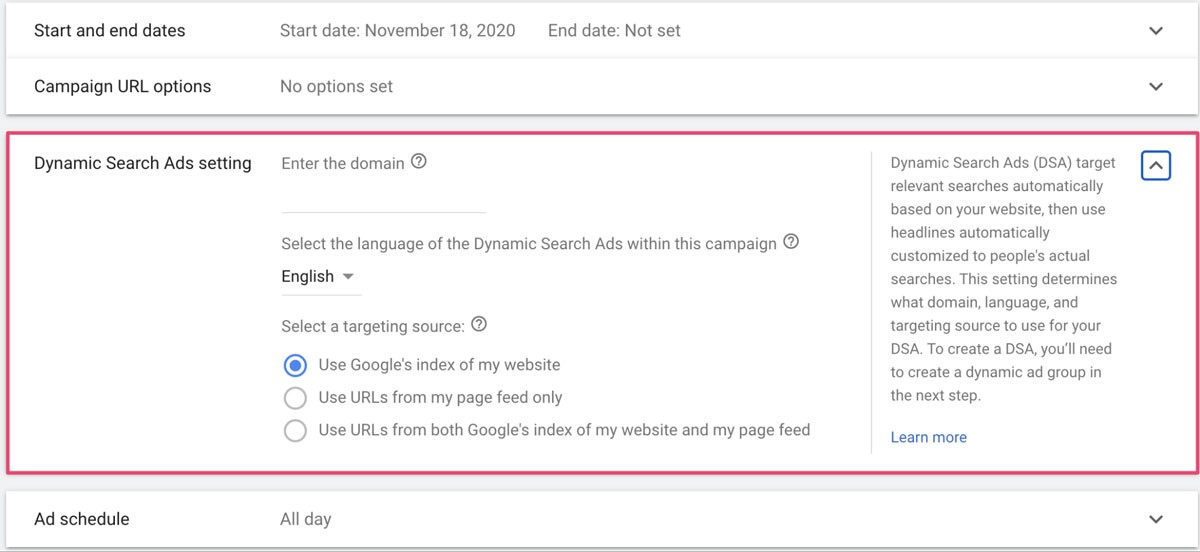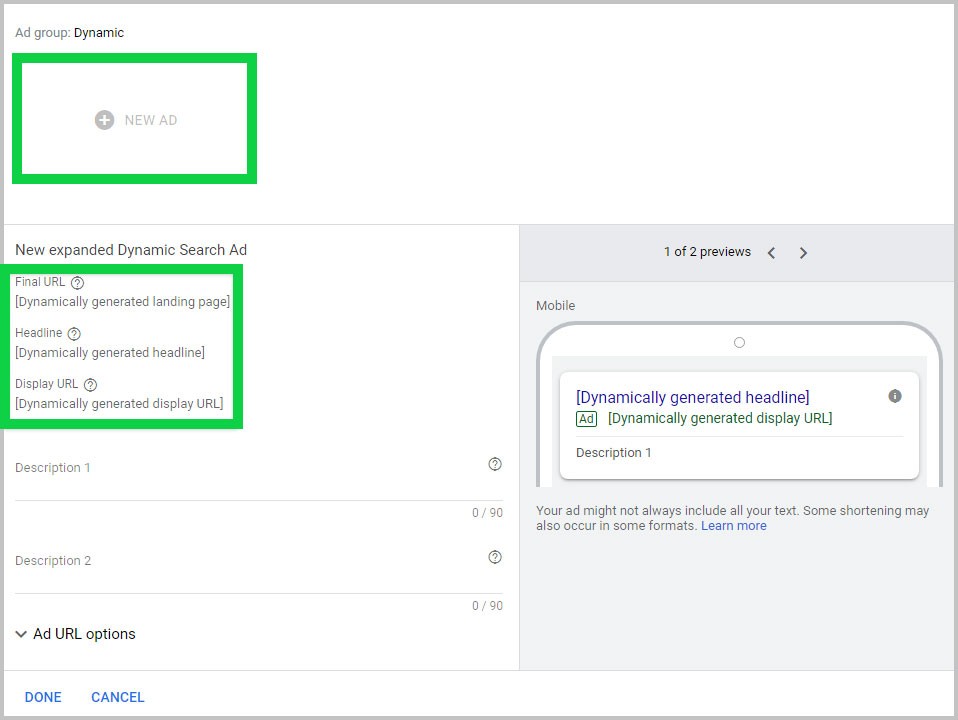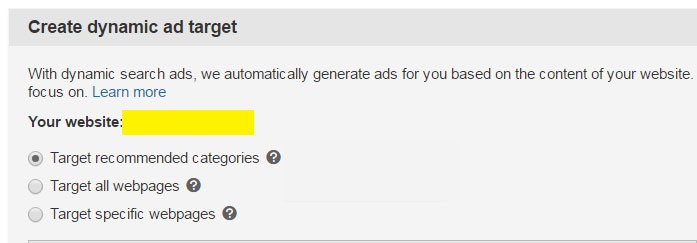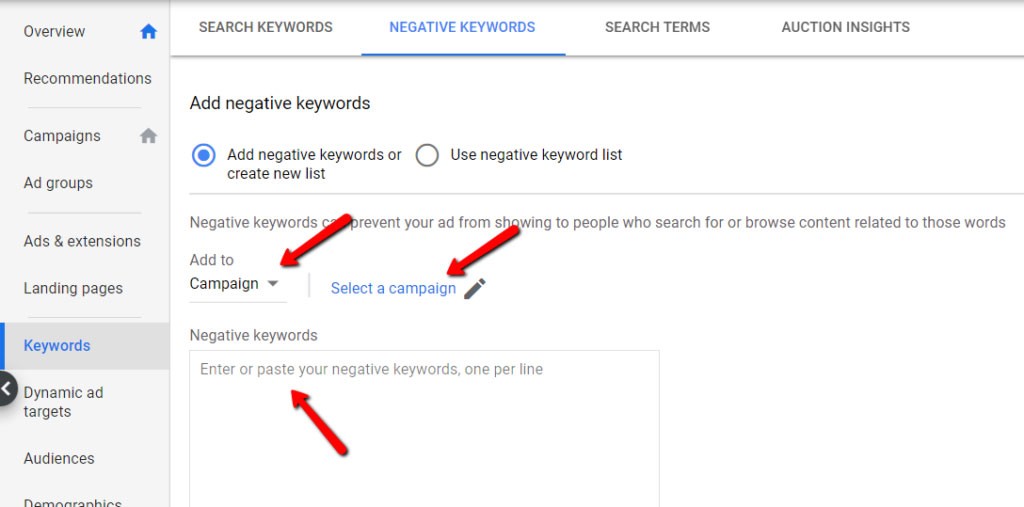Are you looking to fill the gaps that your other search campaigns are slacking? You have come to the right place. Here is an ultimate guide to creating Google Dynamic Search Words.
Despite the popularity of Shopping Campaigns and Search Ads, it didn’t take long before eCommerce businesses, as well as digital marketers, caught a breath of fresh air – Google Dynamic Search Ads (DSA).
Dynamic Search Ads have negated the need for creating individual bids, texts, and keywords in a digital campaign. The biggest advantage is that you save time, attract more CTR (Click Through Rate), and gain more traffic through targeted campaigns.
That said, how do you make the most out of DSAs for better ROIs and increased traffic? This guide details what DSAs are, the benefits, who they are meant for, and how to create and use them. So, read along.
FACTS:
- 24% of marketers use paid advertising to impact direct sales.
- 68% of marketing leaders use guided selling technology or tools.
(HubSpot)
What are Dynamic Search Ads?
In a nutshell, DSAs are ads that are automatically generated and matched to relevant queries a user makes on a web page. Google dynamically crawls your website and generates an ad with a headline and a landing page that corresponds to the search term.
Instead of creating ad copies for all the possible matches to the content on your site, dynamic ads enable you to target the entire website or parts of the web pages for better search results, giving your product or service the spotlight in the search engine results.
How to Create Google DSAs
Creating a Google DSA campaign is easy. Simply follow the following steps:
- STEP 1 – Log in to your Google Ads account
- STEP 2 – Click ‘Campaigns’ from the menu
- STEP 3 – Click on the + (plus button) then hit ‘New Campaign’
- STEP 4 – Choose a goal for the campaign you are creating. You can also continue without creating a goal
- STEP 5 – After choosing the goal, choose ‘Search’ as your type of campaign
- STEP 6 – Select the type of results you want from the campaign before continuing
- STEP 7 – Give your campaign a name and input the target locations, the desired language, and your budget
- STEP 8 – If you choose to use ‘Bidding’, you can have Google optimize the bids for you by choosing the automated bid strategy. From here, you can also enter your bid limit – this is optional – and your budget as well
- STEP 9 – Then from the General Settings, click expand to reveal more settings then click on the ‘Dynamic Search Ad’
- STEP 10 – From here, type the URL of your website and enter the language and click ‘Save’ For example:

(Image Credit: AdEspresso)
We can set-up and optimize your Google Ads for you but let’s also test your website’s SEO potential. Takes 60 seconds!
Paying for traffic is an important way for many businesses to grow but ranking naturally in Google for your important keywords is free. While Diib helps 1000s of businesses grow with Google Ads management, Diib is also one of the best SEO tools in the world and uses the power of big data to help you quickly and easily increase your traffic and rankings. Diib will even let you know if you already deserve to rank higher for certain keywords. As seen in Entrepreneur!
- Over 500,000 global members
- Keyword and backlink monitoring + ideas
- Built-in benchmarking and competitor analysis
- Easy-to-use automated SEO tool
- Speed, security, + Core Vitals tracking
- Too busy for SEO? Diib’s Growth Experts can set-up and optimize your ads!
Used by over 500k companies and organizations:
Syncs with 
Creating Dynamic Ad Group
After completing those steps, you can now continue to create Dynamic Ad Group and Targets. The most recommended way of setting up DSA Ad Groups is by setting them up depending on the structure of your site. For instance, if you are an eCommerce platform selling multiple products, create ad groups for every category. This will make the ads more relevant to the customer.
Other than that, here are the steps to creating a DSA Ad Group:
- STEP 1 – From the Ad type, go with the default option by selecting ‘Dynamic’
- STEP 2 – Next, give your Dynamic ad group a name
- STEP 3 – Determine how you would like to have your ads targeted. There are a few things to consider in this step, and they include:
- Landing Pages: You can choose to target all the web pages you want or are running search ads against. This choice gives you the versatility of increased traffic if you already have existing ad groups or other campaigns running across your accounts. If you are new to DSA, this is the option you should start with.
- Other Categories: This type of targeting is aimed at a set of different site pages grouped by theme. Using this option, you can target page titles, the page content – which is simply targeting based on the search terms – and the page feed, which avails you with a chance to make use of the existing product feed to increase coverage alongside automatically updating your search ads, depending on the product categories. Here’s how you can use a feed to target DSAs. Remember, if your site recently set up DSA ads, you may have to give way for a day for the categories to show.
- Specific URLs: You can also target specific page domains. This is by far the easiest way to focus on individual pages. The downside, however, is that achieving incremental traffic is significantly reduced. The image below shows what these options will look like:

(Image Credit: Apps Maven)
- STEP 4 – Before clicking Save and Continue, you should make adjustments to your bids if you are not using Google’s automated bidding. This way, you have more control over when your ad is shown and where.
- STEP 5 – Click ‘Save’ and ‘Continue’
Adding DSA Ads to Dynamic Ad Group
Google DSAs allow you to create multiple ads, giving you the ability to monitor and collect data on the most successful campaign. To add a search ad to a Dynamic Ad Group, follow these steps:
You Might Also Like
- STEP 1 – Click ‘New’ ad
- STEP 2 – Proceed to ‘Dynamic Search Ad’
- STEP 3 – Google will automatically generate the DSA headline, the final, and the display URLs. So, just input your description
- STEP 4 – Save and Continue

(Image Credit: Seer Interactive)
How to Optimize Your DSA Campaigns
There are a few things you need to answer first if you want to get the most out of your DSA ads. Do a thorough survey and determine where you are missing coverage and where you need to improve.
This can be done by carefully evaluating the existing keyword campaigns and how they are aligned with the sole objective of your business. With this knowledge and special consideration of the different types of products or services you offer, you can then structure your ads and set them up for success.
To optimize your DSAs effectively:
1. Have in Place a Stellar Campaign Structure
Be specific in your ad groups as much as possible because this is where the automated targets are derived from. Whether the target is a set of pages, product inventory, specific URLs, or page titles, a granular campaign structure comes highly commendable.
For example, if you have an eCommerce platform with a DSA campaign for the different types or categories of shoes you sell, it makes more sense to have dynamic groups for each category for auto-targets such as men’s shoes, children’s shoes, women’s shoes, sports shoes, among other categories. This way, you can create tailored descriptions and let Google do the rest.
2. Map Your Queries
Mapping your keywords appropriately and focusing on a ‘catch-all’ type of campaign is another way of making the most of your DSA ads. Make sure that you add negative keywords to the various dynamic groups and campaigns to filter results and show the user only the most relevant ads.
After successfully creating your desired campaign structure, create a final catch-all DSA campaign. This ad serves to capture all the other search terms that don’t appear in your auto-targets. Of course, this option is optional, but if you want to catch all the queries that match the content across your web pages, then have your catch-all DSA ad target ‘All Webpages’. For instance:

3. Add Negative Keywords to Improve Experience
Negative keywords play a huge role in any keyword campaign. As such, it is important to mine for these words and add them to your DSA campaign. Doing this will redirect more traffic to your site.
However, exclude as many generic keywords as you can to avoid paying more for something that doesn’t bring you a return on investment. It is also important to continue adding more keywords that speak volumes, and not just the negatives for increased conversion. This is where you go to add negative keywords to your campaign:

(Image Credit: CXL)
4. Utilize Promos/Offers
If you are on an eCommerce platform, you could highlight services such as free shipping, sales promos, and fast delivery among others. This is beneficial, considering that Dynamic Search Ads dynamically generate headlines, and this will woo more users to your site. They will get to see the products or services you offer as well as the offers and other benefits they will enjoy from trying them.
5. Utilize Smart Bidding
If you are just setting up your DSA campaigns, you can utilize smart bidding to improve the performance of your website. More information on bidding is discussed below.
How to Manage Your DSA Bids
Your DSA bids can be fully automated – as mentioned earlier – or partially automated with Enhanced Cost Per Click (ECPC). The automated option is done by Google AI, which can bid up and down, depending on the specific keywords searched.
Bid adjustments in Google Ads Dynamic Search Ads are determined by percentages. For example, if you have a running campaign that is performing well, say on smartphones, but has a maximum cost per price (CPC) of $1, and you want to reach more people, you can increase your bid by 20 percent, which will make the CPC $1.20. Also, you can lower the bid by 20percent, reducing the CPC to $0.80, depending on what you want to achieve.
The bidding can be adjusted, depending on the targeting options, device, location, and demographics. The complete list of bidding types is discussed here.
To use the partial bidding system with Enhanced CPC, largely consider the structure of your campaign. Make sure that your dynamic targets are categorized – it could either be by the URLs, the web content, or category.
Thereafter, set a specific bid for each target as opposed to having every web page as a target. From there, bid depending on the Return on Advertising Spend (ROAS). If your ROAS is better than the dynamic target, bid higher, but if it is worse, bid lower. There is a setting available to see the recommended bid for a DSA, for instance:

(Image Credit: Thrive Business Marketing)
How Long Does it Take for You to Get Results?
After creating your Google Ads Dynamic Search Ads campaign, it is important to give it time. The results may not be generated instantly, particularly if your website is extensive. Google will take its time crawling all the web pages to gather all the appropriate data for a conclusive analysis. It can take up to a month for the strategy to be effective, but it is worth it.
But despite Google doing all the work for you, it comes highly recommended that you keep an eye out to ensure that the landing pages and the headings align and are relevant to the search term.
Are Google Dynamic Search Words for You?
Google DSA ads make a great fit for your website if it has a wide inventory of products or numerous landing pages. This way, the dynamic ads will help users find relevant content on your site without a hassle.
On the other hand, if your site doesn’t change much, that is, if the content on your website is more static, you probably won’t need them since you can effectively manage the landing pages. Nonetheless, if you want to create awareness of your brand, the ads are ideal for promoting the content.
Also, if you have existing campaigns, and you want to capture all the relevant queries not captured by the campaign for better targeting, DSAs will serve you well.
We hope that you found this article useful.
If you want to know more interesting about your site health, get personal recommendations and alerts, scan your website by Diib. It only takes 60 seconds.
Why Use Google DSA Ads?
Now that your question of what are dynamic search ads has been answered, you are probably wondering what their benefits are. Well, here are some advantages to creating them for your site:
- Generate Higher Traffic – DSAs are great for campaigns. By allowing Google to automatically generate headlines based on the search query, it has the potential to increase the number of visitors to your site by using target ads.
- Automatic Updates – When your inventory or the service you offer on your website changes, DSAs are automatically updated as Google scrapes through the content, finding the relevant content one is looking for.
- Saves You Time – Without necessarily mapping out the keywords to use, setting up DSAs is swift and easy. The keywords and the headlines are automatically generated.
- Improves Overall Efficiency – By collecting the relevant and necessary data for the user and dynamically generating headlines and redirecting them to a landing page, the efficiency of your website is gradually improved.
- Campaign Control – Through DSAs, Google will automatically offer decent campaign control, but you can still manage the type of content, product, or service to show using the targeting options. This way, if, for example, you sell a particular product, and it runs out of stock, you can exclude it from the ad targets.
- Dynamically Generate Headlines – Creating a catchy headline is not everyone’s forte, and having Google generate them for you for various ads is such a plus.
- Reduced CPC – Since they work so well with long-tail searches – which carry reduced CPC and less competition – DSAs have a relatively low ad spending if set properly.
- Complements Other Keyword Campaigns – If you want to fill in the gaps not covered by your other keyword campaigns, the DSA dynamic search ads are the way to go. They will allow you to reach a broader audience for that additional traffic you so desire. By scanning through your web pages, DSAs effectively fill any gaps that are highlighted in your keyword-based targeting ads.
Things to Keep in Mind
There are potential downsides to using Google DSAs. To be safe, keep in mind the following:
- They Target Broad Audiences: DSAs largely target a broad audience, and this could make your overall ads account suffer, especially if it is the only tool you are using. You may miss on high-value keyword targets. So, ensure that it complements other campaigns and or use it as a back-up option.
- Not All Keywords are Relevant: Not all the keywords that DSAs display are relevant to the audience since Google scrapes content from your landing pages.
- Dependent on Good Optimization: DSAs are highly dependent on how well your site is optimized. If your website is poorly optimized, you may find yourself struggling with this strategy. The best way to utilize it optimally is to keep the website meta-data up-to-date, ensure the pages are accessible, and that the user interface is easy to navigate and is mobile-compatible.
- Using it Isn’t Free: Although it often attracts a low CPC due to the long-tail search words, using them with existing campaigns or setting them up to target all web pages may incur some increased ad spending.
- No Control Over What Client Sees: Since Google creates the headlines automatically, you don’t have control of what the user sees. Some results may be overwhelming, especially in poorly optimized sites.
All things considered, it is important that you try creating a few DSA dynamic search ads to gauge its performance and whether it is behaving the way you expected.
Conclusion
DSA ads are a great way to elevate the visibility of your search ads and your website in general. They automate campaigns, helping you save lots of time you would have spent creating individual keyword-based ads for each product or service you offer on your website. Partnering with Diib Digital can offer you an added measure of security that your search ads are hitting their mark and lucrative. Here are a few of the features that set us apart from our competitors:
- Keyword, backlink, and indexing monitoring and tracking tools
- User experience and mobile speed optimization
- Bounce rate monitoring and repair
- PPC monitoring, including ETAs and conversion rates
- Social media integration and performance
- Broken pages where you have backlinks (404 checker)
- Technical SEO monitoring
Click here for your free scan or simply call 800-303-3510 to speak to one of our growth experts.
FAQ’s
Dynamic search ads happen when Google crawls your website or blog and analyzes your content. Then search ads are created based on what keywords or search terms are within your webpage content.
- Sign-in or create an account for Google Ads.
- Select Campaigns on the left menu.
- Select New Campaign after clicking the plus button.
- Determine and select one of more campaign goals.
- As your campaign type select Search.
There are two dynamic search ads features that can be very useful. First, destination URLs are kept up-to-date and recent without you changing them. Second, you can automatically find keywords using machine crawling.
First, optimize your website for your advertisements. Target specific audiences based on your user behavior. Utilize negative keywords, if you don’t want a specific word or phrase in your ad add it to your negative keyword list. Finally, take time to focus on your descriptions for your ads.
Dynamic ad groups are a new ad group type that Google Ads now provides. They are the only ad group you can put dynamic search ads into.



